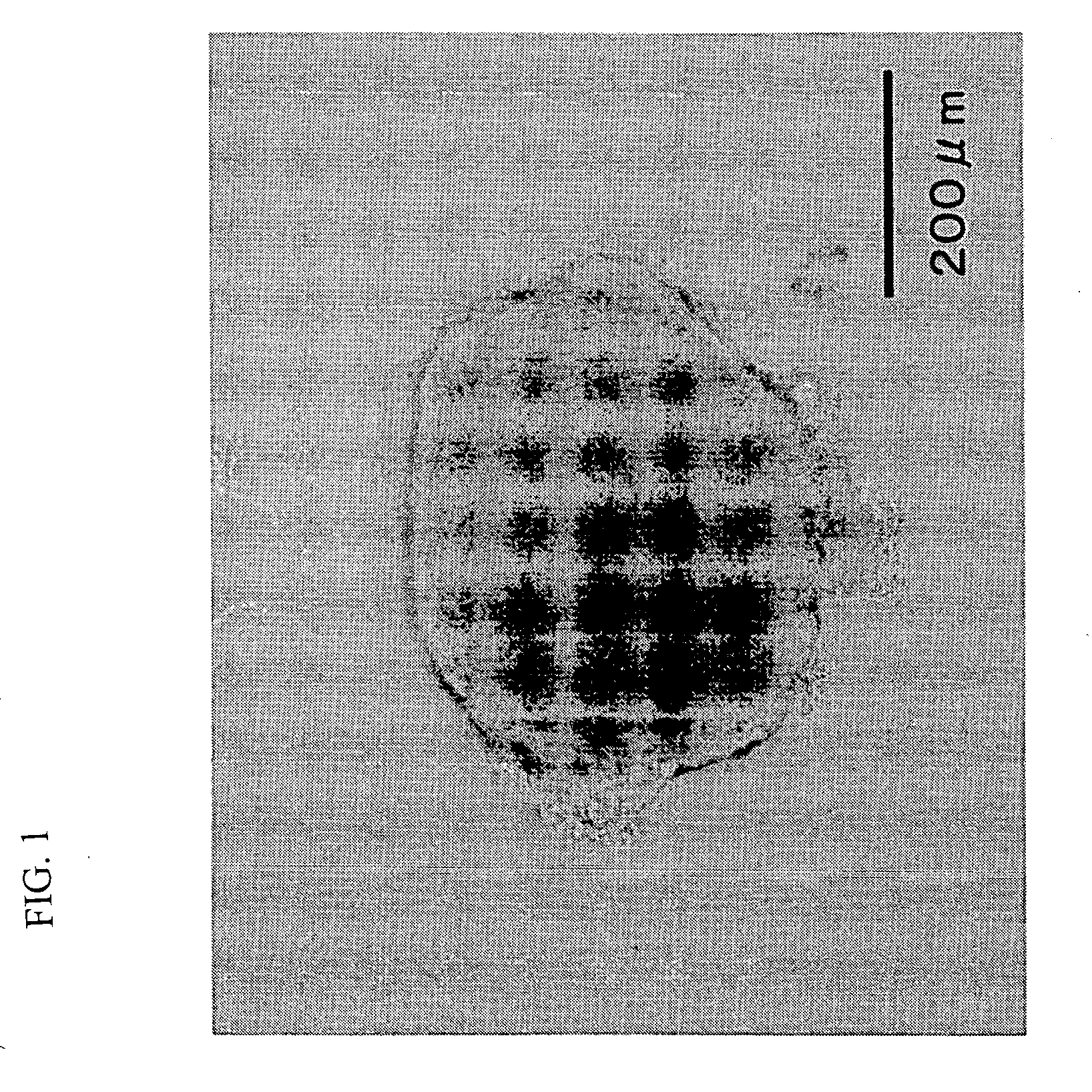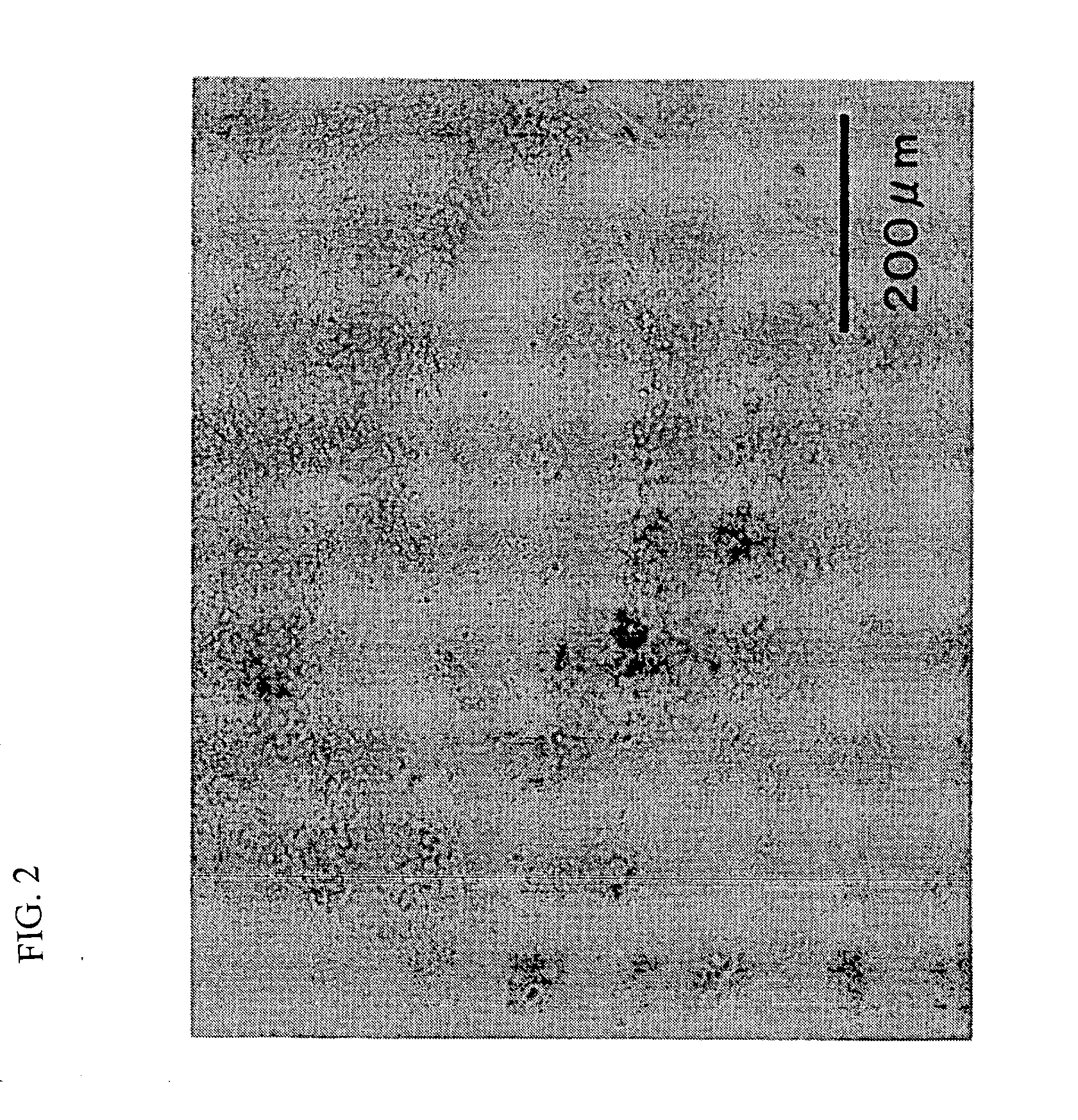Container for germ layer formation and method of forming germ layer
- Summary
- Abstract
- Description
- Claims
- Application Information
AI Technical Summary
Benefits of technology
Problems solved by technology
Method used
Image
Examples
synthesis example 1
[0050] 35.7 g of MPC and 4.3 g of n-butylmethacrylate (BMA) (MPC / BMA=80 / 20 (by molar ratio)) were dissolved in 160 g of ethanol, placed in a four-neck flask, and bubbled with nitrogen for 30 minutes. 0.82 g of azobisisobutyronitrile was added at 60° C., and reacted for polymerization for 8 hours. The obtained polymer liquid was added dropwise into 3L of diethyl ether under stirring, and the resulting precipitate was recovered by filtration, and vacuum dried at room temperature for 48 hours, to obtain 29.6 g of powder. The weight average molecular weight of the obtained powder measured by GPC under the following conditions, was found to be 153000. Compositional analysis by 1H-NMR revealed that MPC / BMA=80 / 20 (by molar ratio). The powder is designated as copolymer (A).
(1) Sample: A sample was dissolved in a chloroform / methanol (6 / 4 (by volume)) mixed solvent containing 0.5 wt % lithium bromide to prepare a 0.5 wt % polymer solution. The amount of the sample solution used was 20 L.
[0...
synthesis example 2
[0052] 38.0 g of MPC and 2.0 g of glycidyl methacrylate (GMA) (MPC / GMA 90 / 10 (by molar ratio)) were dissolved in 358 g of isopropanol, placed in a four-neck flask, and bubbled with nitrogen for 30 minutes. 2.18 g of a toluene solution of 20 wt % t-butyl peroxypivalate was added at 60° C., and reacted for polymerization for 5 hours. The obtained polymer liquid was added dropwise into 3L of diethyl ether under stirring, and the resulting precipitate was recovered by filtration, and vacuum dried at room temperature for 4.8 hours, to obtain 28.4 g of powder. Compositional analysis of the powder by 1H-NMR revealed that MPC / GMA=90 / 10 (by molar ratio). The weight average molecular weight measured by GPC under the same conditions as in Synthesis Example 1 was found to be 53000. The powder is designated as copolymer (B).
synthesis example 3
[0053] 12.6 g of MPC, 8.6 g of BMA, and 6.0 g of GMA (MPC / BMA / GMA=30 / 40 / 30 (by molar ratio)) were dissolved in 358 g of isopropanol, placed in a four-neck flask, and bubbled with nitrogen for 30 minutes. 2.18 g of a toluene solution of 20 wt % t-butyl peroxypivalate was added at 60° C., and reacted for polymerization for 5 hours. The obtained polymer liquid was added dropwise into 3L of diethyl ether under stirring, and the resulting precipitate was recovered by filtration, and vacuum dried at room temperature for 48 hours, to obtain 28.4 g of powder. Compositional analysis of the powder by 1H-NMR revealed that MPC / BMA / GMA=30 / 40 / 30 (by molar ratio). The weight average molecular weight measured by GPC under the same conditions as in Synthesis Example 1 was found to be 42000. The powder is designated as copolymer (C).
PUM
 Login to View More
Login to View More Abstract
Description
Claims
Application Information
 Login to View More
Login to View More - R&D
- Intellectual Property
- Life Sciences
- Materials
- Tech Scout
- Unparalleled Data Quality
- Higher Quality Content
- 60% Fewer Hallucinations
Browse by: Latest US Patents, China's latest patents, Technical Efficacy Thesaurus, Application Domain, Technology Topic, Popular Technical Reports.
© 2025 PatSnap. All rights reserved.Legal|Privacy policy|Modern Slavery Act Transparency Statement|Sitemap|About US| Contact US: help@patsnap.com



